Saffron
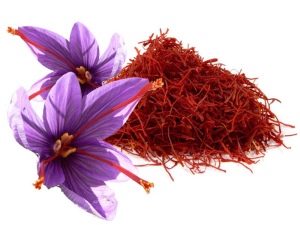
Saffron is the most expensive spice, which is why it is also called "red gold" due to its red tint and high cost. It is widely used in cooking as a spice, as well as for coloring dishes.
Titles in other languages:
- lat. Crocus sativus;
- English Saffron;
- German Gewürz Safran;
- fr. Safran.

Appearance
Saffron seed or crocus seed belongs to the family Iris or Kasatikovyh (Iridaceae). This perennial plant is a relative of the crocus. It only blooms in autumn. Tubers sprout narrow-shaped leaves and flowers of a pale purple hue. Its height reaches from 10 to 30 cm. The bulbs look like a tuber, the diameter of which is up to 3 cm. Leaves and flowers sprout from the bulb. The leaves of the plant are erect and narrowly linear.
One bulb can have from 1 to 3 large flowers. Each flower has many yellow anthers and one long yellow pistil, which ends in three orange-red stigmas and is 2.5–3.5 cm long. It is the stigmas that are used to prepare the spice.


Kinds
- Kashmiri is grown in India. It has a dark red tint, long stigmas and a special aroma.
- Spanish is produced in Spain. It is dried in special ovens using fire. Coupe is the most expensive and best variety, because it is harvested from the fragrant red tops of the stigmas.Superior is quite common, it is made from a whole stigma, so it has a slight aroma.
- Iranian is considered the cheapest and most common among other species.


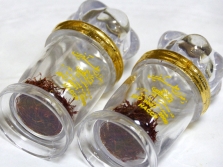
Where does it grow?
Saffron belongs to heat-loving plants, therefore it prefers the territory with hot summers. This spice is grown in Greece, Pakistan, Spain, Iraq, India. It is also grown in Portugal, Crimea, China, Japan, Transcaucasia. The wild species can be found in almost all countries of the world.
Most of all, Spain, India and Iraq are engaged in cultivation, because they provide the whole world by 80%.

Where and how to choose a spice?
Depending on the quality and color of the threads, saffron can be:
- Natural consists of flower threads of red and yellow shades and may contain anthers and pistil residues. It is of low quality.
- Saffron only from red flower threads - high quality. This spice passes quality control.


The Spanish or Indian saffron has the highest value. If the price of a spice is low, then it is American safflower or marigold. This spice is not added with spoons, but several saffron strings are used. To obtain a rich color and subtle aroma, this amount is quite enough. They are easily crushed by hand before adding to the dish.
Some merchants cover the threads with glycerin to increase the weight, and therefore earn more. To expose dishonest sellers, you need to try saffron, glycerin gives a sweet taste. You also need to pay attention to the color - the real one has a dark red color.

Pigments have coloring properties, so it should not be kept in the sun, but only in a hermetically sealed container.
When buying ground saffron, you can buy turmeric, these spices look very similar. So that sellers cannot mislead you, you must buy it only in sealed, labeled packaging.

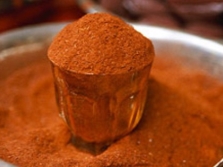

To determine the freshness of this spice, it is enough to have a glass with a warm hand on hand. Fresh threads will quickly swell, and the water will turn yellow, but stale threads will remain in their original form.

spice making method
- During the flowering of the spice, flowers are collected, each of which blooms separately for only three days. The plantation of this plant blooms for about 30 days.
- Saffron flowers are collected only in good sunny weather.
- Next, stigmas are plucked from each flower, their number is three things.
- Then they are dried under the rays of the hot sun or special dryers are used, where the drying process takes from 15 to 30 minutes, depending on the temperature used.
- Carefully sort the threads, separating red from orange.
- To determine the type of spice, threads are dipped into the water - those that fall to the bottom are the highest grade, and those that remain afloat are of the lowest grade.
- Store saffron in a sealed container.


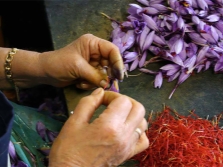
Peculiarities
- Propagated by division of the tuber-bulb.
- The plant blooms from September to November, depending on where it is grown.
- Has a strong aroma.
- The seasoning has a bitter, slightly pungent taste.
- The threads of the plant are soft to the touch.

Nutritional value and calories
100 grams of saffron contains:
| Squirrels | Fats | Carbohydrates | Water | Ash | Alimentary fiber | calories |
|---|---|---|---|---|---|---|
| 11.43 gr. | 5.85 gr. | 61.47 gr. | 11.9 gr. | 5.45 gr. | 3.9 gr. | 310 kcal |
You can learn more about saffron from the video.
Chemical composition
Saffron has a rich chemical composition, so it has a beneficial effect on the entire body. This spice contains a large amount of nutrients. Content in 100 grams of dry product:
| vitamins | Macro- and microelements | ||
|---|---|---|---|
| A (RE) | 27 mg | Ca (calcium) | 111 mg |
| B1 (thiamine) | 0.115 mg | Mg (magnesium) | 264 mg |
| B2 (riboflavin) | 0.267 mg | Na (sodium) | 148 mg |
| B6 (pyridoxine) | 1.01 mg | K (potassium) | 1724 mg |
| B9 (folic) | 93 mcg | P (phosphorus) | 252 mg |
| C (ascorbic) | 80.8 mg | Fe (iron) | 11.1 mg |
| PP (niacin equivalent) | 1.46 mg | Zn (zinc) | 1.09 mg |
| Cu (copper) | 328 mcg | ||
| Mn (manganese) | 28.408 mg | ||
| Se (selenium) | 5.6 mcg |
Useful properties, effect on the body
- It has a diaphoretic, antispasmodic and antibacterial effect on the body.
- This spice is a strong antioxidant, therefore it is used for cell regeneration.
- This component is used as a strong aphrodisiac.
- It has a tonic effect on the entire body, and also relieves fatigue.
- A vitamin cocktail of saffron and water has a beneficial effect on dry skin, it becomes silky and young.
- In combination with other herbs, this expensive spice helps with coughs, indigestion, bloating, baldness, and insomnia.

Harm
It is strictly forbidden to eat a large amount of saffron for food, because only 5 grams has a strong toxic effect on the human body.
It must be taken in small doses. Overdose can lead to overexcitation of the nervous system, drug intoxication, poisoning or death.
Contraindications
- You can not use during pregnancy, because this spice can provoke an increased tone of the uterus or uterine bleeding;
- In large doses, it acts as a narcotic substance;
- Enhances the effect of intoxication if you use spice with wine;
- Do not give to children under two years of age;
- It is forbidden to use this spice in diabetes.

Oil
The essential oil of saffron is called saffronol.Today it is used in various cosmetic products: shampoos, gels, lotions, creams or masks for face and hair. Also on its basis create expensive perfumes and incense.
Use of essential oil:
- 3-7 drops are added to the baths
- for massage use 5 drops per 5 grams of base
- 5 drops per 5 grams of base are added to creams and masks
- for reflex massage use this oil with transport oil (1: 1)
- 2-3 drops are enough for aroma medallions
- for rheumatism, a mixture of a few drops of saffron oil and 0.5 teaspoon is used. tablespoons of almond oil. This solution is rubbed into diseased joints.
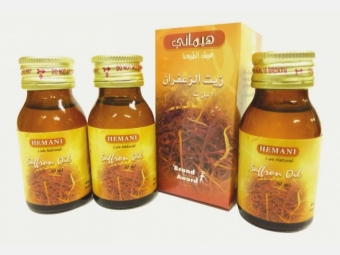

Application
In cooking
It is better to buy saffron in the form of threads, because the ground spice can be diluted with other spices. In the presence of impurities, in the ground form, it can lose its unique flavor.
The main ways to prepare the spice before adding it to food:
- Before adding the thread, it is necessary to soak in warm water or milk, they also make a tincture of alcohol. Next, the spice is added to food along with the solution.
- In a dry frying pan, fry the stigmas of the spice a little, then make a powder out of them, pour warm milk over it and let it brew for 30 minutes. This mixture can be added to baked goods or to various rice dishes.
- Spice as a powder can be consumed without pre-soaking.
The real rich aroma of saffron can be fully felt only after 12 hours.

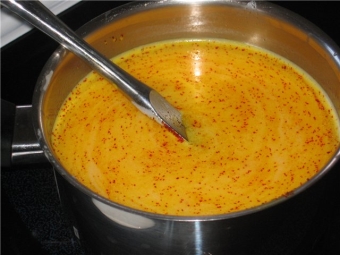
- This spice is very famous in the Mediterranean, Southeast Asia and the Middle East, it is added to fish, meat or rice dishes. For example, Provencal fish soup (bouillabaisse), Milanese risotto or sweet pilaf with almonds, cashews and raisins.
- In Europe, saffron is used to color cookies and cakes, and can also be added to soups, rice dishes, sauces, pasta and various desserts.
- This spice is used as a seasoning for sweet sauces, dairy dishes, mousses and jellies, cream and ice cream, as well as for a variety of pastries.
- In Mediterranean cuisine, this spice is added to seafood, various broths and soups, sauces and butter. This spice goes well with tomatoes, asparagus or cauliflower.
- This spice is added as a flavoring agent to liqueurs and soft drinks.
- The spice is added to tea or coffee with milk, just two stigmas will give an unforgettable aroma to a hot drink.
Saffron has a peculiar aroma, so they try to use it separately from other spices, but, nevertheless, it creates a harmonious combination with such spices: thyme, cilantro, basil, cinnamon or rosemary. This spice is added to a wide variety of dishes.



Recipes
Korean cabbage
Ingredients:
- Half head of cabbage
- 1 liter of water
- 1 st. a spoonful of 70% vinegar
- 3-4 strands of saffron
- 1 onion
- 2 cloves of garlic
- 2 tbsp. spoons of sugar
- A pinch of red and black pepper, coriander and salt
- A little vegetable oil
Cooking
Finely chop the cabbage and pour boiling water over it, let it brew for 10 minutes. Drain the water.
We are preparing the marinade. Separately, boil a liter of water in a saucepan. Add all spices to boiling water: black pepper, coriander, saffron, vinegar, salt, sugar and garlic. Cut the onion into cubes and fry in vegetable oil, add red pepper to it. Next, the onion is added to the pot with spices, and cook over low heat. Pour the cabbage with the finished mixture with spices. We put in the refrigerator for 24 hours.

Rice
Ingredients:
- 250 grams of rice
- 1 st.a spoonful of water with milk
- 1 teaspoon olive oil
- 0.5 tsp. spoons of saffron
- Salt to taste
Cooking
First, rinse the rice thoroughly and pat dry. Pour 1.5 liters of water into a saucepan, bring to a boil, then add olive oil, rice and cook over low heat for 15 minutes. Take milk with water, heat it up a little and add saffron, let it brew for a few minutes and pour it into a pot with rice. Mix thoroughly. This side dish is suitable for pork chops and baked meat.
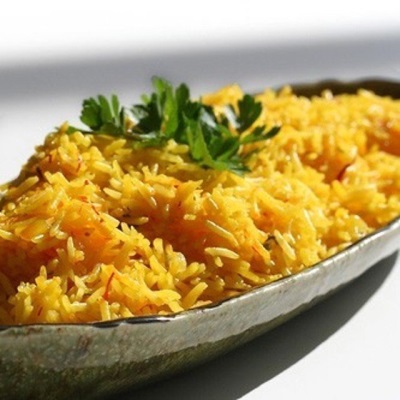
saffron sauce
Ingredients:
- 1 bulb
- 3-4 strands of saffron
- 500 ml cream
- 1 st. a spoonful of vegetable oil
- Salt to taste
Cooking
Finely chop the onion, add the saffron and fry over low heat until the onion becomes transparent. Then add cream and salt, continue to cook until thickened. This sauce is suitable for meat dishes.

In medicine
Saffron has a beneficial effect on the entire human body, and to enhance this effect, doctors recommend using it in combination with black pepper and ginger.
Saffron is used in medicine for various diseases:
- increases the number of red blood cells in the blood;
- improves heart function;
- normalizes blood pressure;
- improves blood composition;
- helps with vision problems;
- with diseases of the cardiovascular system;
- helps to relieve inflammation of the gums;
- with vascular disease;
- regulates fat metabolism;
- helps to deal with stressful situations;
- helps in the early stages of atherosclerosis, hypertension, coronary heart disease and angina pectoris;
- used for asthma;
- fights bouts of severe coughing;
- used for diseases of the spleen and stomach ulcers;
- favorably affects many systems of the body: nervous, digestive, circulatory and female reproductive;
- strengthens and calms the nervous system;
- fights convulsions and spasms, therefore it is used for epilepsy.
- soothes with depression, hysteria, fears or overexcitation.
You can learn about the use of saffron in medicine from an excerpt from the program "Live healthy!"
Saffron is effectively used to treat the following diseases:
- Saffron with milk helps strengthen the heart and nervous systems, improves skin condition, fights depression. You need to take 1 liter of milk and add 0.1 grams of saffron.
- For external use, lotions are used to help fight severe headaches, migraines and insomnia. It is necessary to prepare a mixture of 3 strands of saffron and 3 drops of ghee. This solution must be rubbed into the nostrils, and also dripped into the nose.
- For menstrual disorders or pain, 5 threads per day are enough. To relieve prenatal pain, you need to increase the dose to 10-12 threads.
- With internal bleeding, a healing mixture will help. It is necessary to mix 5 strands of spice, 0.5 tsp. spoons of turmeric and a glass of hot milk.
- With diseases of the blood and liver, 3 strands of spice, 10 pieces of raisins and half a glass of cold water without boiling will help. Then let it brew for eight hours and consume 2 times a day.


In cosmetology
Face masks with saffron moisturize and soften the skin. Take 1 teaspoon. a spoonful of liquid honey, 2-3 strands of saffron and 1 tablespoon of sour cream. Mix all the ingredients and apply on the face for 20 minutes, then rinse thoroughly with warm water.
pros
- All cosmetic products based on saffron have a strong rejuvenating effect, because this plant stimulates metabolic processes inside the cells.
- It has a wound healing property, therefore it protects the skin and prevents the occurrence of inflammatory processes.
- It is a very popular ingredient in expensive face creams and other cosmetic products for body, hair and skin care.



Varieties
Kashmiri saffron has three varieties:
- Shahi
- Mogra
- Lachha
Spanish saffron has two varieties:
- coupe
- Superior
Collection and cultivation
Collecting saffron takes a lot of time and effort.
To get 1 kilogram of this spice, you need to work hard for dozens of workers all day:
- In the morning, the collection of flowers begins, which have a light purple color.
- From each flower you need to get the stigmas of an orange-red hue. This is a very long and monotonous work, so it is done by all family members.
- The threads are dried and only after that they acquire their original flavor.


Saffron is usually grown in hot climates. About eighty percent of the spice is produced in Iraq and Iran. Growing saffron in the climatic conditions of Russia is almost impossible.

Story
It is assumed that the birthplace of the plant is Central Asia or the island of Crete, because there are no exact facts. It is known that in the second millennium BC, saffron was actively grown in the eastern Mediterranean. In Egypt, it was used as a valuable medicine that helped fight various diseases. Clothes and shoes that were dyed with it were very popular.
Today it is difficult to say where this spice was first grown. Researchers presumably name Asia Minor, India and Iran. In ancient times, the Romans called it crocus and used it as a medicinal preparation or a dye.Over time, interest in this plant has disappeared significantly. And only a few centuries later, saffron acquired a new life in Spain, where it was brought by the Arabs. Then it began to be grown in Italy and France.
Interesting Facts
- To get just 1 kg of saffron, you need to process from 80,000 to 150,000 flowers.
- There are 450 to 500 stigmas in one gram of saffron.
- One hectare of plantation yields 6 kg of spice in the first year, and up to 20 kg in the second year.


















I was in India, I was on a saffron plantation. Beauty is indescribable!